Just as water is essential to life, so is first aid. In fact, a serious first aid emergency without certain first aid skills could be a recipe for disaster.
Today we will be learning about CPR and Choking first aid. I will cover the basics, link to more advanced CPR and choking material and then provide you with some free printable reminder cards.
Why Learn CPR:
Here are some statistics from the American Heart Association:
- Nearly 383,000 out-of-hospital sudden cardiac arrests occur annually, and 88 percent of cardiac arrests occur at home.
- Many victims appear healthy with no known heart disease or other risk factors.
- Statistically speaking, if called on to administer CPR in an emergency, the life you save is likely to be someone at home: a child, a spouse, a parent, or a friend.
- Effective bystander CPR provided immediately after sudden cardiac arrest can double or triple a victim’s chance of survival, but only 32 percent of cardiac arrest victims get CPR from a bystander.
- Sadly, less than eight percent of people who suffer cardiac arrest outside the hospital survive.
WOW! Only 32% of out-of-hospital cardiac arrest victims are getting CPR from a bystander! If that number was 100% we could potentially save more than 65,000 additional lives each year! CPR is simple (especially hands-only CPR) and I believe everyone should learn it!
ABC or CBA?
The first time I was trained in CPR years ago, I was taught to remember A-B-C (Airway, Breaths, Compressions), but that changed in 2010.
The American Heart Association found that people were spending too much time figuring out how to open the airway or trying to find a CPR mask etc. This caused a delay in getting to the life-saving chest compressions.
Chest compressions are essential in getting the blood flowing again. Victims of cardiac arrest can go a minute or two without taking a breath and without any brain damage. (just like you can hold your breath underwater). But every second counts when it comes to blood flow.
In 2010, the American Heart Association changed the order of CPR to C-A-B (Compression, Airway, Breaths) in order to reflect the greater importance of compressions.
Hands-Only CPR:
In addition, the American Heart Association now recommends “Hands-Only-CPR” for adult or teen victims who suddenly collapse. Hands-Only-CPR is simply CPR without breaths. It is so simple that ANYONE can learn it right from their home. The steps to Hands-Only CPR are simple: (1) call 9-1-1 and (2) push hard and fast (think of the beat to the disco song “Stayin Alive”) on the center of the chest until professional help arrives. Here is a quick video you can watch:
Learn more about Hands-Only CPR here.
REMEMBER: Hands-only CPR is best for adults or teens that you actually see collapse. But if you aren’t trained in conventional CPR and you are trying to help a child, infant, drowning victim, etc, hands-only CPR won’t hurt and could help. In accordance with CPR, learn also the basics of the Heimlich Maneuver.
Conventional CPR:
You can learn conventional CPR! Classes don’t take that long! You can find CPR classes from the American Heart Association in your area here and an online course here (there is a cost for this online course). You can find classes from the Red Cross here. You can also find completely free online courses here.
Causes of Choking
When anything gets stuck in the windpipe or throat and blocks the airway, choking occurs. In cases involving adults, food is frequently to blame. Young kids frequently choke on tiny items. Threats to life include choking. It robs the brain of oxygen. Immediately administer first aid if you or someone else is choking.
Choking cuts off the oxygen to your brain. It is essential to get that oxygen flowing again as soon as possible. Young children and older adults are the most common victims of choking. If you care for either of these, be certain you know the proper first aid response.
Signs of Conscious Choking:
The universal sign of choking is hands clutched to the throat. But victims may or may not give that signal. If you notice the following in a conscious victim, they may be choking:
- Inability to talk
- Difficulty breathing or noisy breathing
- Inability to cough
- Skin, lips, and nails turning blue or dusky
If your victim is coughing, do not administer first aid, but instead encourage them to continue to cough.
First Aid for Conscious Choking Victim:
From the American Red Cross:
If you encounter an adult, conscious, choking individual that is coughing, encourage continued coughing. If the victim is unable to cough, speak, or breathe, complete the following:
- Send someone to call 9-1-1
- Lean the person forward and give 5 back blows with the heel of your hand.
- Give 5 quick abdominal thrusts by placing the thumb-side of your fist against the middle of the victim’s abdomen, just above the navel. Grab your fist with the other hand.
- Repeat until the object the person is choking on is forced out and the person breathes or coughs on his or her own.
You should only try to get an object out of the victim’s mouth if you can see it. If you can see it in their mouth do a finger sweep. Otherwise, move straight into back blows and thrusts.
If you are alone, perform back blows and abdominal thrusts for at least 1 minute before calling 911. If another person is available, have that person call 911 immediately while you perform first aid.
First Aid for an Infant Choking Victim:
From the Mayo Clinic:
- Assume a seated position and hold the infant facedown on your forearm, which is resting on your thigh.
- Thump the infant gently but firmly five times on the middle of the back using the heel of your hand. The combination of gravity and the back blows should release the blocking object.
- Hold the infant faceup on your forearm with the head lower than the trunk if the above doesn’t work. Using two fingers placed at the center of the infant’s breastbone, give five quick chest compressions.
- Repeat the back blows and chest thrusts if breathing doesn’t resume. Call for emergency medical help.
- Begin infant CPR if one of these techniques opens the airway but the infant doesn’t resume breathing.
First Aid for an Unconscious Choking Victim:
If someone who is choking becomes unconscious, lay them down and do a finger sweep if you can see the object be careful not to push it further down. Then, immediately begin CPR. The compressions may dislodge the item and will get as much oxygen to the brain as quickly as possible. More info here from the Mayo Clinic.
How to learn choking First Aid:
You can find CPR classes from the American Heart Association in your area here and an online course here (there is a cost for this online course). You can find classes from the Red Cross here. You can also find completely free online courses here.
FREE PRINTABLES:
I have taken many CPR classes over the years. But I’m still afraid that when (and if) the time comes, I will be frazzled and might forget something essential. A while back, I made a printable first aid quick guide for myself and my babysitters that has been helpful. However, I’ve been wanting something a bit more portable: something smaller.
Now I’m making printable 3×5 cards! I will print them, laminate them and then attach them to a key ring. I will keep one hanging in the pantry, one in each vehicle, and one in our 72 hour kits / go-bags. You are welcome to print them for your own use as well! Simply click HERE or on the image below to download them:
You can find more printable cards at the links below:
- Shock and Severe Bleeding First Aid Basics
- Hypothermia and Heat Stroke
- Free PDF Printable: First Aid Quick Reference Guide
Disclaimer:
I am not a doctor. My advice is simply what I have found from my own research and education. Please read the information I have linked to for more expert sources and take a first aid / CPR course for complete training.
References:
PIN THIS NOW TO SAVE FOR LATER!
Becky is a wildlife enthusiast and pet and livestock care expert with a diploma in canine nutrition. With over a decade of experience in animal welfare, Becky lends her expertise to Simple Family Preparedness through insightful info about pets, livestock, bee keeping, and the practicalities of homesteading.

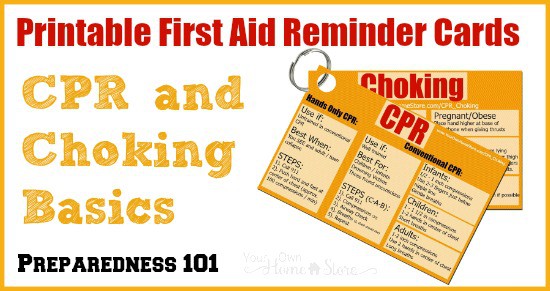
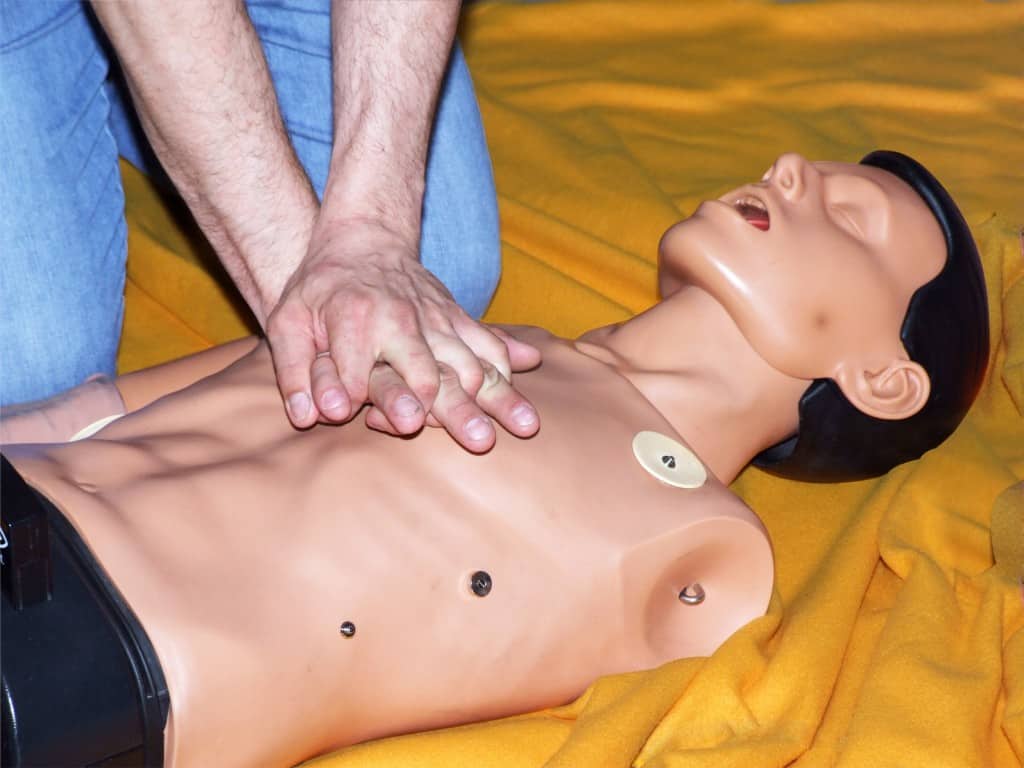
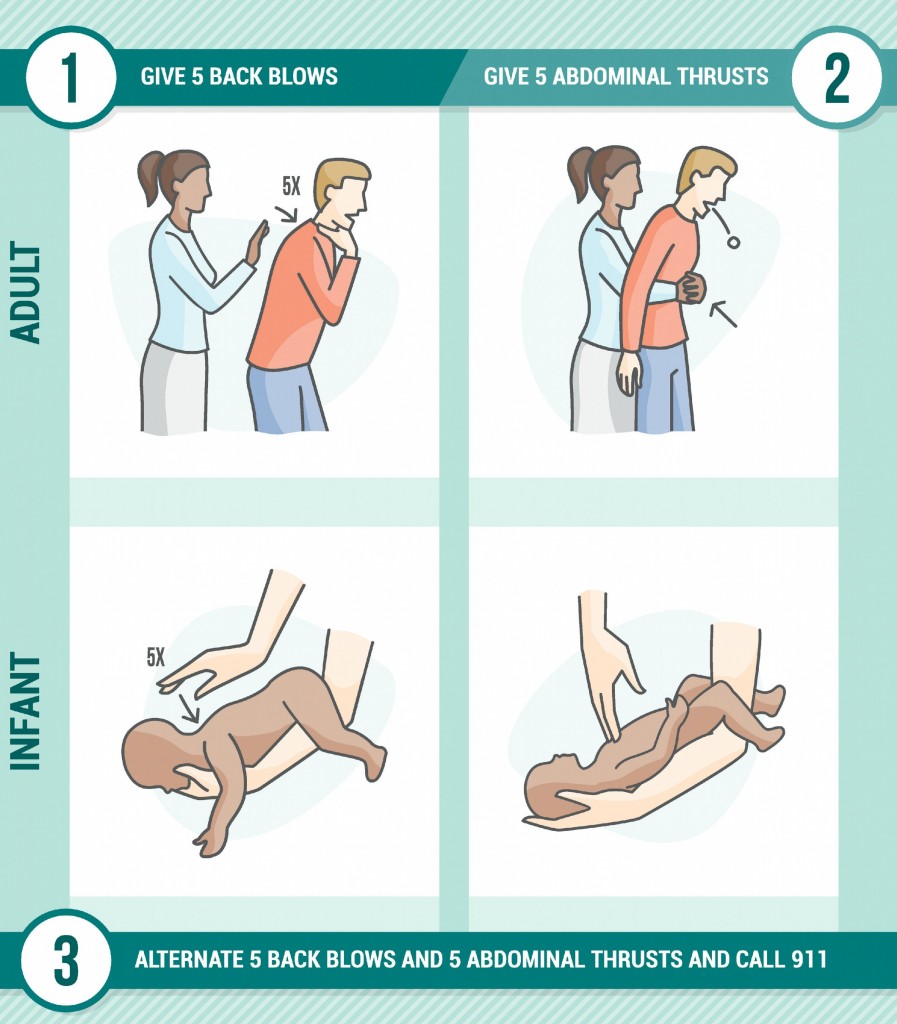
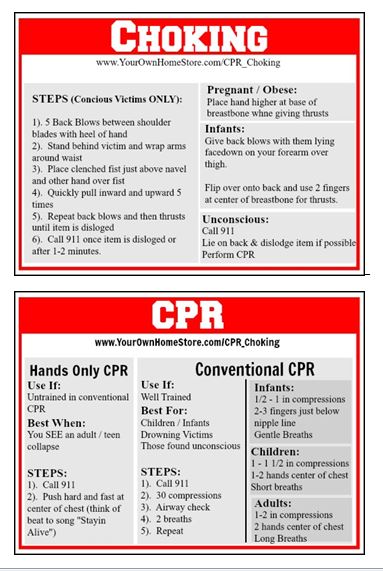
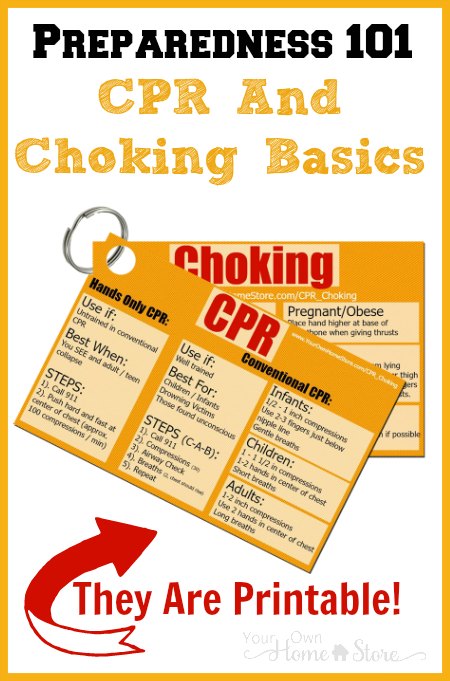

need choking cpr
This is great information regarding both CPR and choking First Aid. Both skills can come in handy during an emergency and make a major difference when it comes to life or death situations. It is best to get certified in both CPR and basic First Aid by those that are professionally trained to teach others and have experience in the medical field or in similar emergency situations. I appreciate your use of infographics, as they make understanding CPR and choking First Aid easier. I also like that you are helping people to be prepared by offering free printables. This information can go a long way and help save a lot of lives.
For more information on why you should become certified in CPR, check here – https://chesapeakeaedservices.com/reasons-get-cpr-certification/
Thanks Jon! I absolutely agree that it is best to get trained. These are only meant to be reminders for those that are trained, not a replacement for it. I appreciate the link!
I love these 3×5 printables to put on a ring and keep in my first aid kit. Do you have any besides the ones here and the shock/bleeding ones? I’m looking for a set that’s covers a bit more.
I don’t have any other cards Darcy, but have a one page printable here: https://simplefamilypreparedness.com/first-aid-quick-guide/
Hi, I am wanting to print the first aid cue cards. I cropped them and then tried printing them at costco. They ended up be a little blurry. Do you have any suggestions? Thank you!
Great post! However, how do I print the Orange, Yellow and Red CPR and Choking Basics Cards? I printed the Red and White ones, but the other ones that state “They Are Printable” with the red arrow look very well laid out also and I would like to print them as well. I just don’t see a link or any way to print them. Thanks for all you do!!
They are actually teh exact same Angela, just different colors. I don’t have the orange, yellow and red ones anymore. I got some complaints that they were hard to read when printed, so I re-did them in the red and white.
Can you share what program you used to make them? These are great. I would like to give color coding a try.
To make the printable LeEtta? I just used MIcrosoft word.
Is that the program you used to design them?
Yep!